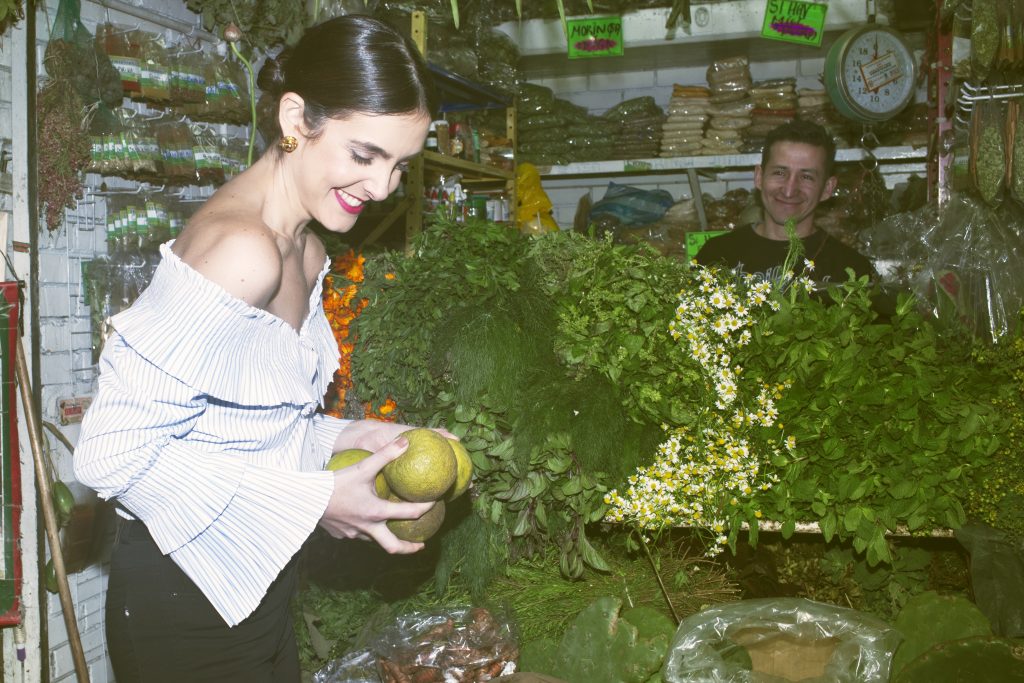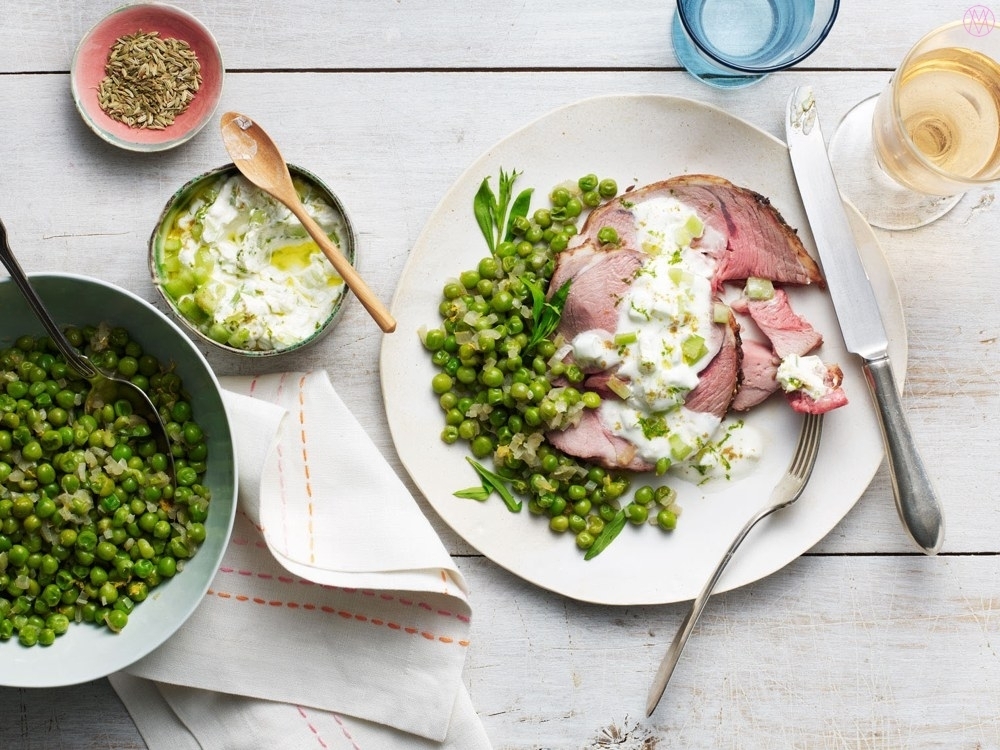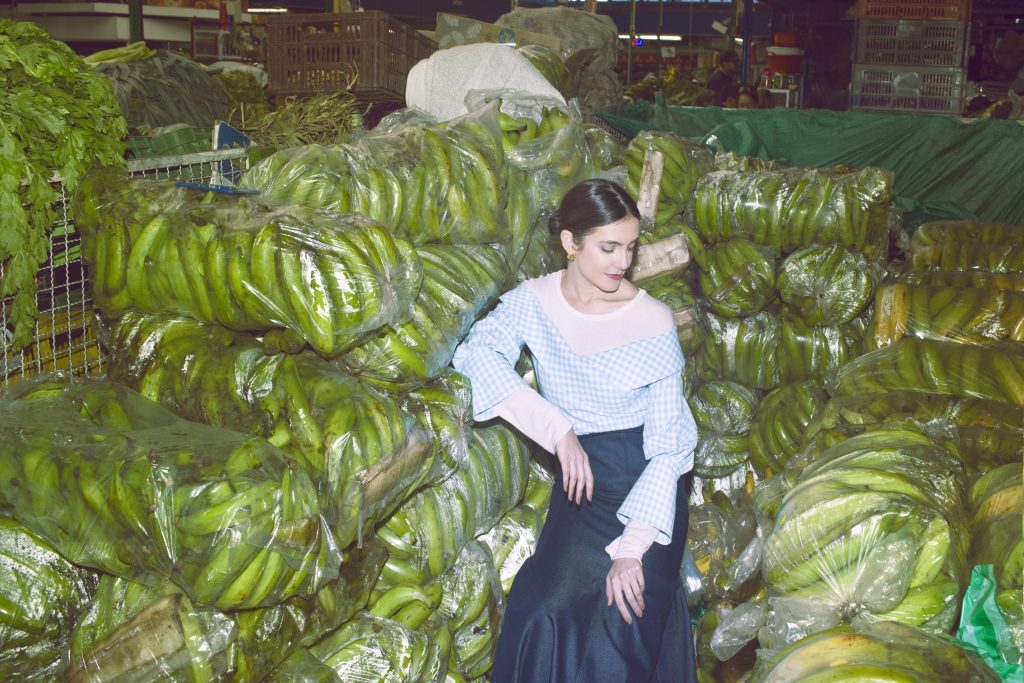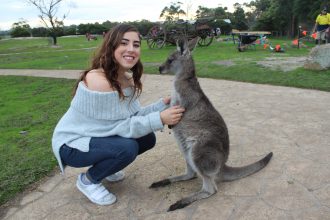MARIANA VELÁSQUEZ ARTISTA DE LA MESA/AN ARTIST AT THE TABLE

Por/By Liliana Pérez Coymat
Fotos/Photos: Alejandra Quintero Web: www.alejandraquintero.net · Intsagram: @alequint
La colombiana Mariana Velásquez se desempeña exitosamente como estilista culinaria en Nueva York, se codea con prestigiosos fotógrafos como Quentin Bacon, con estrellas como Bradley Cooper, sus proyectos terminan en las portadas de renombradas revistas como la Revista Gourmet y ya cumple uno de sus grandes sueños: publicar sus propios libros de cocina. Su trayectoria ha estado marcada por una serie de mujeres extraordinarias que trazaron su camino por el arte de la mesa. ¿Quiénes son esas mujeres?
You would think that Mariana Velásquez has it made, with a successful career as a food stylist in New York City; working with renowned photographers such as Quentin Bacon, and movie stars such as Bradley Cooper and her styling featuring on the covers and inside stories of specialized magazines such as Gourmet, Bon Appetit, Fine Food, and important books such as First Lady Michelle Obama’s cookbook “American Grown” and The Food of Morocco, winning the James Beard award for best international cookbook. But now she has accomplished another of her dreams: publishing her own cookbooks. Her career has been influenced by a league of extraordinary women whom she has met on her path through the art of the table. But, who are these women?
Su madre y sus abuelas
Mariana creció en Bogotá, en un ambiente donde la mesa era muy importante. Su madre, la reconocida empresaria de la marca de elementos para la mesa Carmiña Villegas, fue su primera fuente de inspiración. “Nos sentábamos a comer todas las noches, la mesa puesta con varias piezas, entrada, plato fuerte y postre… era todo un ritual.
Mis abuelas tuvieron gran influencia en mí. En la cocina de una de ellas, de origen libanés, siempre había movimiento. Esa exquisitez del medio oriente que se traduce en las mesas de la costa colombiana, todo el tema sibarita y la sensibilidad por los detalles que me marcó muchísimo. Y la casa de mi otra abuela, fue siempre el eje de la familia. Ella tenía ancestros alemanes, entonces hacía chucrut, pastelería, carnes al horno braseadas por horas, y nos invitaba a los nietos a compartir con ella. Entonces siempre la cocina entre líneas hacía parte de la conversación, eso fue la base de todo para mi”.

Plaza de Mercado de Paloquemao, Bogotá, Colombia.
Her mother and grandmothers
Growing up in Bogotá, Mariana was surrounded by an environment where food and table etiquette were very important. Her mother was her first source of inspiration; she is a well-known business woman who created a brand with her own name, Carmiña Villegas, which imports European and U.S. kitchen and food items. “We used to sit down for dinner at night, and our table was set with various china pieces, with an entrée, a main course and a dessert was a complete ritual.
Both of my grandmothers also had a great influence on me. In the kitchen of one of them, of Lebanese origin, where the exquisiteness of the Middle East was brought to the tables of the Colombian Coast, was full of movement; all done with an epicurean touch and such a sensibility for details, all of which marked me enormously. My other grandmother’s home was always my family’s axis. She had German ancestors, thus she made sauerkraut, pastries and cakes, meats were cooked in the oven for hours, and she invited us grandchildren to cook and share the food with her. So the kitchen was always part of the conversation, always there between the lines and that was the beginning of everything for me”.
¿Cómo decides estudiar para ser Chef?
En la adolescencia cuando uno busca su lugar yo hacía las tortas de cumpleaños en el colegio y sentía que me validaban mucho. Me encantaba hacer la torta de chocolate de los libros de Los Caballeros de la Buena Mesa del Club del Gourmet y otras recetas. En uno de los viajes de mi mamá a una feria de hotelería en Chicago me trajo los folletos de la Escuela de Cocina CIA en upstate New York, entonces dije “¡ah, esto puede ser una carrera!”. Seguí cocinando pero mis papás pensaron que era un hobby. Cuando me gradué del colegio entré como practicante al restaurante de Harry Sasson. ¡Durante seis meses pelé langostinos y mis papás creían que eso me iba a desmotivar (risas)! Pero yo quedé encantada con esa profesión. La metodología, la organización, la rigurosidad del oficio, la interacción con la gente… entonces Harry me animó.
Así es como Mariana llegó al Post Ranch Inn en Big Sur, California donde hizo una pasantía que marcaría su vida por siempre.

Plaza de mercado Paloquemao en Bogotá, Colombia
When do you decide to study to become a Chef?
As a teenager looking for my place in the world, I used to bake cakes at school and I felt that they validated me. The chocolate cake from The Gentlemen of the Good Table, a cookbook by the Gourmet Club was my favorite! One day, after one of my mother’s trips to a hotel fair in Chicago she brought me the brochures from the Culinary Institute of America (CIA) in upstate New York, and I said, “Ah, this can be a degree!”. I continued cooking but my parents thought it was a hobby. When I graduated from school I was an intern at Harry Sasson’s restaurant. I peeled shrimp for six months, and my parents thought that it would discourage me (laughter)! But I loved the profession. The method, the organization, the discipline, and the interaction with people… then Harry encouraged me and afterward I went to work at the Post Ranch Inn at Big Sur, California as an intern, experience that changed my life forever.
¿Cómo fue esa experiencia?
Fue el pilar de mi carrera, entendí la importancia del origen de los ingredientes, de la belleza… ¡Cuando todavía no se hablaba de farm-to-table cuisine, era así! El sitio era espectacular, los manteles eran de lino pesado impecablemente planchado, los platos eran de vidrio hechos a mano, las flores comestibles… era como revivir la importancia de los elementos de la mesa de mi mamá. Esa formalidad y honorabilidad por el oficio me dio la base para todo.
What was that experience like?
It became the pillar of my profession, I understood the importance of the ingredients origin, about beauty… it was all important. At that time, Farm-to-table was not even talked about yet! The place was spectacular, the tablecloths made of heavy linen were impeccably ironed, the plates were hand-blown glass, the flowers were edible… It was like reviving the importance of the elements of my mother’s table. It was that formality and honorability of the profession that provided me with the basis for what I’d do next.

Foto: Buenlimón (sitio web de Mariana Velásquez www.marianavelasquez.com)
Tres mujeres la introducen al food styling
Mariana decidió estudiar en una escuela de cocina en Vermont con el sueño de algún día hacer libros de cocina. Con ello en mente tuvo el primer contacto con la Revista Saveur, donde a través de la escuela consiguió unas prácticas de ocho semanas en Nueva York. Una vez allí, trabajó en el restaurante Prune donde conoció a la chef Gabrielle Hamilton, una inspiración determinante para ella. “Ella me mostró que se puede tener ese tesón de un buen chef pero con el toque femenino, sin necesidad de ser una chef pastelera, que era la alternativa para las mujeres que querían estar en la cocina en esa época”.
Y es en la Revista Saveur donde también conoció a la fotógrafa Brooke Slezak quien vio algo en ella y le habló del estilismo culinario (food styling) por primera vez. “¡Yo no sabía nada de eso y ella me contó que hay gente que se dedicaba a ello!”. Slezak la contactó a su vez con la food stylist Jee Levine, quien finalmente la contrató como su asistente y le enseñó todo sobre la actividad. Tres años después, la misma Levine la impulsó a independizarse.
Three women introduced Mariana to food styling
Mariana decided to study at a cooking school in Vermont dreaming of someday writing cook books. With that in mind, she made the first contact with Saveur Magazine, and through the school, she obtained an eight-week of training in New York City. Once there, she worked at the Prune restaurant and met Chef Gabrielle Hamilton, a determining inspiration for her. “She showed me that you can have a man’s tenacity with a woman’s touch, without having to be a pastry chef, which was the alternative for women that wanted to be in the kitchen in those days”.
At Saveur, Mariana met photographer Brooke Slezak who saw something in her and talked to her about “food styling” for the first time. “I didn’t know such a thing existed, but she told me that there were people working professionally on it! Slezak put her in contact with food stylist Jee Levin, who finally hired her as her assistant, and taught her everything about the field. Three years later, Levin herself pushed Mariana to become independent.
¿Cómo fue ese comienzo?
Muy difícil. Era 2008, la crisis, las revistas estaban cerrando. Dos años muy duros, de poco trabajo, pero me mantuve y las cosas se empezaron a dar. Mi estilo se fue definiendo y hoy en día me contratan para trabajos con un estilo muy particular, muy orgánico, suelto, relajado, que parece que no hay esfuerzo en hacerse, pero tiene como un finesse que lo hace especial.
How did it go in the beginning?
It was very hard. It was 2008, there was the financial crisis and the magazines were closing down. Two very hard years with very little work, but I maintained myself and things started to get better. My style was being defined, and today they hire me for projects calling for a very particular style, very organic, loose, relaxed, and appearing effortless, but with a finesse that makes it special.

Foto: Buenlimón (sitio web de Mariana Velásquez www.marianavelasquez.com)
¿El food styling se puede definir como un arte?
Es un arte pero también uno tiene que entender muy bien las técnicas culinarias para saber cómo se comportan los alimentos. Y por otro lado, esa sensibilidad artística, entender un poco de fotografía y del manejo de la luz para saber cómo trabajar con los elementos y sacarles el mejor provecho visualmente.
Entre otros proyectos, Mariana trabajó en la Casa Blanca con el libro “American Grown” de Michelle Obama, hizo una portada para la Revista Gourmet, varios libros para los reconocidos chefs Rausch en Colombia, colaboró con Vogue México y Vogue Latinoamérica y sacó adelante un difícil proyecto para Häagen Dazs “eran unas fotos de esculturas con helado, ¡me sacó canas y una úlcera (risas)! Fue un trabajo muy difícil, con muchísima presión, pero me abrió muchas puertas en el mundo de los congelados” y le permitió luego trabajar al lado de Bradley Cooper en otro proyecto para la misma marca de helados.
Can food styling be defined as art?
It is an art but you have to know culinary techniques well enough to know how food behaves. And on the other side you have to have an artistic sensibility, you need to know a little photography and also how to manage light in order to produce the best advantage visually.
Among other projects, Mariana has worked with clients in diverse sectors and places in the gastronomical world. First Lady Michelle Obama included her styling in her White House cookbook “American Grown”, she had one cover for Gourmet Magazine, collaborated with Vogue Mexico and Vogue Latin-America magazines, worked with several chef authored cookbooks such as the Rausch brothers of Colombia and carried forward a challenging project with Häagen Dazs“ that consisted of a photo shoot for sculptures made out of ice cream! It involved a high degree of difficulty and pressure. “It almost turned my hair white and gave me an ulcer (laughter)! But it opened many doors in the world of frozen products for me”; which later lead to a project with actor Bradley Cooper for the same ice cream company.
El mundo del food styling se ve glamoroso, trabajar con fotógrafos, directores de arte, artistas de cine… ¿es así?
Sí, tiene algo glamoroso, estamos en estudios de fotografía con luz natural que tienen una vista a la ciudad espectacular o trabajamos en locación en unas casas increíbles con unas cocinas que ¡uno se quiere morir! Pero a la vez es un trabajo en el que hay que cargar cosas, organizar, lavar platos, además de estar todo el tiempo cocinando entonces ¡olemos a pollo toda la semana (risas)!
The world of Food styling looks glamorous; collaborating with photographers, art directors and movie stars… is it that way?
Yes, it is glamourous, we are in photography studios with natural light that have a spectacular view of the city, we also work in incredible homes with kitchens you want to die for!. However, there is also the unglamorous side such as handling all the equipment, washing dishes, and cooking – in addition to smelling like chicken all week (laughter)!
Colaboraciones con mujeres extraordinarias
¿Cómo fue trabajar con Michelle Obama, con la Chef Teresita Román en Cartagena y la Chef venezolana Lorena García?
Fueron proyectos muy distintos. Con Michelle Obama fue una súper experiencia, ¡qué mujer! Es una persona cálida, desde su forma de hablar, de mirarte a los ojos, totalmente conectada, presente, dulce, firme… ¡Fue un privilegio! Con Teresita Román, fue la reedición de “Cartagena de Indias en la Olla”, ¡el libro original tiene tres mil recetas! Hicimos una edición de doscientas y fuimos con el fotógrafo Quentin Bacon a la casa de ella durante quince días, a cocinar con sus dos cocineras de toda la vida y a hacer ochenta fotos. ¡Fue una de esas experiencias absolutamente inolvidables! Y Lorena García es una chef increíble. Con ella hice dos libros, el último se llamó New Taco Classics y fue espectacular, aprendí muchísimo.

Plaza de Mercado de Paloquemao, Bogotá, Colombia.
Partnerships with extraordinary women
How was your experience working with Michelle Obama, Chef Teresita Roman in Cartagena and Venezuelan Chef Lorena García?
It was a great privilege to work with Michelle Obama, what a woman! She is warm, from the way she speaks to you and looks into your eyes, totally connected, and she is sweet but firm. It was an incredible experience! With Teresita Roman, one of the City of Cartagena’s Grand Dames, I worked on the re-edition of her book “Cartagena de Indias en la Olla”, a Colombian best seller [and also awarded in the United States] which first edition included three thousand recipes! We did a two-hundred-recipes edition and went to her home for fifteen days, cooked with her cooks that have worked for her all her life, and with photographer Quentin Bacon who took eighty photos for the new edition. It was a memorable experience! I also collaborated with Venezuelan chef Lorena Garcia on two books, the last one called Taco Classics and it was spectacular, I learned so much from her.
¿Qué mensaje les dejas a otras jóvenes latinas que quisieran incursionar en algo poco tradicional como el food styling?
Les diría que lo más importante es probar cosas que nunca han comido, leer mucho sobre cocina, ir a los mercados locales, entender quién hace los quesos, las cervezas, encontrar esa riqueza de los productores de los ingredientes que consumimos y que son nuestra materia prima. Y luchar por ese sueño con convencimiento, levantarse todos los días a luchar por él.
What message do you want to give to other Latin American women that would like to get involved in food styling?
I would tell them to try food that they’ve never tried, to read all you can about cooking, to go to local markets, to see who makes the cheese, beer; discover the richness in knowing who are the producers of the ingredients we consume, and which are our raw materials. Fight for your dreams with conviction, and fight for them every day from the time you wake up!
Web: www.marianavelasquez.com · Pinterest: @buenlimon · Instagram: @marianavelasquezv

